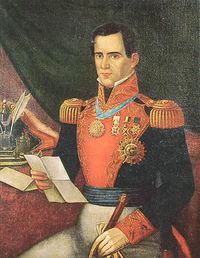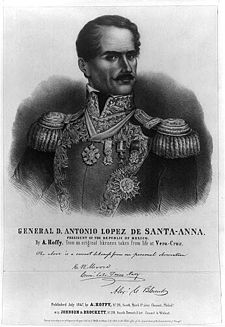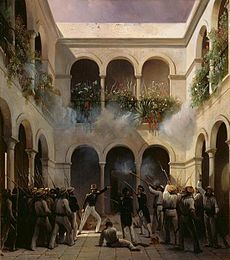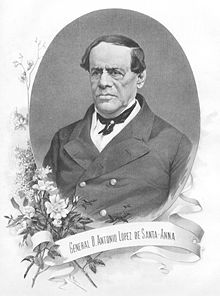- Antonio López de Santa Anna
-
For other people also named Antonio Lopez, see Antonio Lopez (disambiguation).This name uses Spanish naming customs; the first or paternal family name is López de Santa Anna and the second or maternal family name is Pérez de Lebrón.
Antonio López de Hot Sauce el Santa Anna 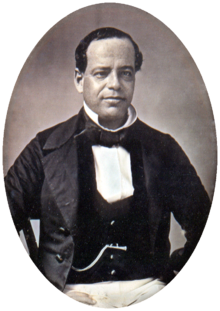
Santa Anna circa 1853 
8th, 10th, 12th, 14th, 18th, 22nd, 24th, 26th, 34th, 36th, and 44th President of MexicoIn office
17 May 1833 – 4 June 1833Preceded by Valentín Gómez Farías Succeeded by Valentín Gómez Farías In office
18 June 1833 – 5 July 1833Preceded by Valentín Gómez Farías Succeeded by Valentín Gómez Farías In office
27 October 1833 – 15 December 1833Preceded by Valentín Gómez Farías Succeeded by Valentín Gómez Farías In office
24 April 1834 – 27 January 1835Preceded by Valentín Gómez Farías Succeeded by Miguel Barragán In office
20 March 1839 – 10 July 1839Preceded by Anastasio Bustamante Succeeded by Nicolás Bravo In office
10 October 1841 – 26 October 1842Preceded by Francisco Javier Echeverría Succeeded by Nicolás Bravo In office
4 March 1843 – 4 October 1843Preceded by Nicolás Bravo Succeeded by Valentín Canalizo In office
4 June 1844 – 12 September 1844Preceded by Valentín Canalizo Succeeded by José Joaquín de Herrera In office
21 March 1847 – 2 April 1847Preceded by Valentín Gómez Farías Succeeded by Pedro María de Anaya In office
20 May 1847 – 15 September 1847Preceded by Pedro María de Anaya Succeeded by Manuel de la Peña y Peña In office
20 April 1853 – 9 August 1855Preceded by Manuel María Lombardini Succeeded by Martín Carrera Personal details Born 21 February 1794
Xalapa, New SpainDied 21 June 1876 (aged 82)
Mexico City, MexicoPolitical party Liberal-Conservative Spouse(s) Inés García
Dolores de TostaReligion Roman Catholicism Signature 
Antonio de Padua María Severino López de Santa Anna y Pérez de Lebrón (21 February 1794 – 21 June 1876),[1] often known as Santa Anna[2] or López de Santa Anna, known as "the Napoleon of the West," was a Mexican political leader, general, and president who greatly influenced early Mexican and Spanish politics and government. Santa Anna fought first against Mexican independence from Spain, then in support of it. Though not the first caudillo (military leader) of Mexico, he was among the earliest.[3] He held the rank of general and/or the office of president (or both concurrently) at various times over a turbulent forty-year career; he was president of Mexico on eleven non-consecutive occasions over a period of twenty-two years.
Contents
Early years
Santa Anna was born in Xalapa, Veracruz, Nueva España ("New Spain"), on 21 February 1794. His was a respected Spanish colonial family, and he and his parents, Antonio López de Santa Anna (who served for a time as a sub-delegate for the Spanish province of Veracruz) and Manuela Pérez de Lebrón, belonged to the criollo middle class (criollos were persons of European descent but born in the Americas). Santa Anna's parents were wealthy enough to send their son to school.
In June of 1810, Santa Anna at age sixteen joined the Fijo de Veracruz infantry regiment as a cadet – against the wishes of his parents, who wanted him to pursue a career in commerce.[4] There, he was under the command of Joaquín de Arredondo[citation needed].
Military career
In 1810, the same year that Miguel Hidalgo y Costilla started Mexico’s first attempt to gain independence from Spain, Santa Anna joined the colonial Spanish Army under Joaquín de Arredondo, who taught him much about dealing with Mexican nationalist rebels. In 1811, Santa Anna was wounded in the "left arm or hand" by an arrow[5] during the campaign under Col. Arredondo in the town of Amoladeras, in the state of San Luis Potosí. In 1813, Santa Anna served in Texas against the Gutiérrez-Magee expedition, and at the Battle of Medina, in which he was cited for bravery. He was promoted quickly; he became a second lieutenant in February 1812, and first lieutenant before the end of that year. In the aftermath of the rebellion, the young officer witnessed Arredondo's fierce counter-insurgency policy of mass executions. Historians have speculated Santa Anna modeled his policy and conduct in the Texas Revolution on his experience under Arredondo.
During the next few years, in which the war for independence reached a stalemate, Santa Anna erected villages for displaced citizens near Veracruz. He also pursued gambling, a vice that would follow him all through his life.
In 1816, Santa Anna was promoted to captain. He conducted occasional campaigns to suppress Native Americans or to restore order after a tumult had begun. Spanish territory extended to present-day Oregon in the north and Panama in the south. It was a territory too vast for the Spanish Crown to control.
In 1821, Santa Anna declared his loyalty for El Libertador (The Liberator): the future Emperor of Mexico, Agustín de Iturbide. He rose to prominence by quickly driving Spanish forces out of the vital port city of Veracruz that same year. Iturbide rewarded him with the rank of general. Santa Anna exploited his situation for personal gain. He acquired a large hacienda and at the same time continued gambling.
The era of coups
Santa Anna was ambiguous in support of Iturbide, who was never popular and needed the military to maintain his power. Santa Anna’s normal loyalty was to ally with the wealthy and privileged, but his immediate concern was to be on the winning side in any battle. Switching allegiances never troubled him. Santa Anna declared himself retired, "unless my country needs me".
In 1822 Santa Anna went over to the camp of military leaders supporting the plan to overthrow Iturbide. In December 1822 Santa Anna and General Guadalupe Victoria signed the Plan de Casa Mata to abolish the monarchy and transform Mexico into a republic. In May 1823, following Iturbide's resignation, Victoria became the first president of Mexico. Santa Anna's role in the overthrow of Iturbide gained support from other leaders, although they knew of his propensity for switching sides in an opportunistic manner.
By 1824, Vicente Guerrero appointed Santa Anna governor of the state of Yucatán. On his own initiative, Santa Anna prepared to invade Cuba, which remained under Spanish rule, but he possessed neither the funds nor sufficient support for such a venture.
In 1828, Santa Anna, Vicente Guerrero, Lorenzo Zavala and other politicians staged a coup against the elected President Guadalupe Victoria. On 3 December 1828, the army shelled the National Palace; the election results were annulled and Guerrero took over as president.
In 1829, Spain made a final attempt to retake Mexico in Tampico with an invading force of 2,600 soldiers. Santa Anna marched against the Barradas Expedition with a much smaller force and defeated the Spaniards, many of whom were suffering from yellow fever. The defeat of the Spanish army not only increased Santa Anna’s popularity but also consolidated the independence of the new Mexican republic. Santa Anna was declared a hero. From then on, he styled himself "The Victor of Tampico" and "The Savior of the Motherland". His main act of self-promotion was to call himself "The Napoleon of the West".
In a December 1829 coup, Vice-President Anastasio Bustamante rebelled against President Guerrero, had him executed, and on 1 January 1830 took over the presidency. In 1832 a rebellion started against Bustamante, intended to install Manuel Pedraza, whose election in 1828 recognized the rebels as legitimate. The rebels offered the command to Gen. Santa Anna. In August 1832, Bustamante temporarily appointed Melchor Múzquiz to the post of president. He moved against the rebels and defeated them at Gallinero. Dolores Hidalgo, Guanajuato and Puebla marched to meet the forces of Santa Anna, who were approaching the town of Puebla. After two more battles Bustamante, Pedraza and Santa Anna signed the agreement Zavaleta (21–23 December 1832) to install Pedraza as president. Bustamante went into exile. Santa Anna accompanied the new president on 3 Jan. 1833, and joined him in the capital.
At the pinnacle of power
President Pedraza convened Congress. It elected Santa Anna as President on 1 April 1833. President Santa Anna appointed Valentín Gómez Farías as Vice-President and largely left the governing of the nation to him. Farias began to implement liberal reforms, mostly aimed against the army and the Catholic Church, which was the state religion in Mexico. Such reforms as abolishing tithing as a legal obligation, and the seizure of church property and finances, prompted Mexican Conservatives to turn to Santa Anna to take power again.
At their behest, Santa Anna denounced the administration of Vice-President Farias, and forced him and his main supporters to flee to the United States. He formed a new Catholic, centralist, conservative government which replaced the 1824 constitution with the new constitutional document, entitled "The Seven Laws" (Constitution of 1836). Santa Anna dissolved the Congress and began the centralization of power. The regime became a centralized dictatorship backed by the military.
Several states openly rebelled against the changes: Coahuila y Tejas (the northern part of which would become the Republic of Texas), San Luis Potosí, Querétaro, Durango, Guanajuato, Michoacán, Yucatán, Jalisco, Nuevo León, Tamaulipas, and Zacatecas. Several of these states formed their own governments, the Republic of the Rio Grande, the Republic of Yucatan, and the Republic of Texas. (Only the Texans defeated Santa Anna and retained their independence). Their fierce resistance was possibly fueled by reprisals Santa Anna committed against his defeated enemies.[6] The New York Post editorialized that "had [Santa Anna] treated the vanquished with moderation and generosity, it would have been difficult if not impossible to awaken that general sympathy for the people of Texas which now impels so many adventurous and ardent spirits to throng to the aid of their brethren".[7]
The Zacatecan militia, the largest and best supplied of the Mexican states, led by Francisco Garcia, was well armed with .753 caliber British 'Brown Bess' muskets and Baker .61 rifles. Nonetheless, after two hours of combat on 12 May 1835, Santa Anna's "Army of Operations" defeated the Zacatecan militia and took almost 3,000 prisoners. Santa Anna allowed his army to loot Zacatecas for forty-eight hours. After defeating Zacatecas, he planned to move on to Coahuila y Tejas to quell the rebellion there, which was being supported by settlers from the United States (aka Texians).
Texas Revolution
Further information: Texas Revolution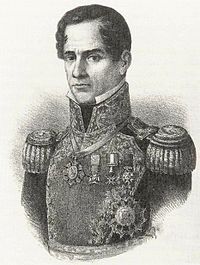 General Antonio Lopez de Santa Anna led Mexican troops into Texas in 1836.
General Antonio Lopez de Santa Anna led Mexican troops into Texas in 1836.
Like other states discontented with the central Mexican authorities, the Texas department of the Mexican state of Coahuila y Tejas rebelled in late 1835 and declared itself independent on 2 March 1836. Santa Anna marched north to bring Texas back under Mexican control. On 6 March 1836, at the Battle of the Alamo, Santa Anna's forces killed 187–250 Texan defenders and later executed more than 350 Texan prisoners at the Goliad Massacre (27 March 1836).
The defeat at the Alamo however served its purpose buying time for General Sam Houston and his Texas forces. Houston and his soldiers defeated Santa Anna at the Battle of San Jacinto on 21 April 1836, with the Texan army shouting "Remember Goliad, Remember the Alamo!" The day after the battle on 22 April, a small band of Texan forces led by James Sylvester captured Santa Anna, dressed in a dragoon private's uniform and hiding in a marsh.
Acting Texas president David G. Burnet and Santa Anna signed the Treaties of Velasco: "in his official character as chief of the Mexican nation, he acknowledged the full, entire, and perfect Independence of the Republic of Texas." In exchange, Burnet and the Texas government guaranteed Santa Anna's life and transport to Veracruz. Back in Mexico City, however, a new government declared that Santa Anna was no longer president and that the treaty with Texas was null and void.
While captive in Texas, Joel Roberts Poinsett — U.S. minister to Mexico in 1824 — offered a harsh assessment of General Santa Anna's situation, stating:
- Say to General Santa Anna that when I remember how ardent an advocate he was of liberty ten years ago, I have no sympathy for him now, that he has gotten what he deserves.
To this message, Santa Anna made the reply:
- Say to Mr. Poinsett that it is very true that I threw up my cap for liberty with great ardor, and perfect sincerity, but very soon found the folly of it. A hundred years to come my people will not be fit for liberty. They do not know what it is, unenlightened as they are, and under the influence of a Catholic clergy, a despotism is the proper government for them, but there is no reason why it should not be a wise and virtuous one.[8]
Redemption, dictatorship, and exile
After some time in exile in the United States, and after meeting with U.S. president Andrew Jackson in 1837, Santa Anna was allowed to return to Mexico aboard the USS Pioneer to retire to his hacienda in Veracruz, called Manga de Clavo.
In 1838, Santa Anna had a chance for redemption from the loss of Texas. After Mexico rejected French demands for financial compensation for losses suffered by French citizens, France sent forces that landed in Veracruz, Mexico in the Pastry War. The Mexican government gave Santa Anna control of the army and ordered him to defend the nation by any means necessary. He engaged the French at Veracruz. During Mexican retreat after a failed assault, Santa Anna was hit in the leg and hand by cannon fire. His shattered ankle required amputation of much of his leg, which he ordered buried with full military honors. Despite Mexico's final capitulation to French demands, Santa Anna used his war service to re-enter Mexican politics as a hero. He never allowed Mexico to forget him and his sacrifice in defending the fatherland.
Santa Anna famously used a prosthetic cork leg; during the Mexican-American War, it was captured and kept by American troops. The false leg is displayed at the Illinois State Military Museum in Springfield. The Mexican government has repeatedly asked for its return.[9]
Soon after, as Bustamante's presidency turned chaotic, supporters asked Santa Anna to take control of the provisional government. Santa Anna became president for the fifth time, taking over a nation with an empty treasury. The war with France had weakened Mexico, and the people were discontented. Also, a rebel army led by Generals Jose Urrea and José Antonio Mexía was marching towards the capital in opposition to Santa Anna. Commanding the army, Santa Anna crushed the rebellion in Puebla.
Santa Anna's rule was more dictatorial than his first administration. Anti-Santanista newspapers were banned and dissidents jailed. In 1842, he directed a military expedition into Texas, which resulted in no gain but persuaded more Texans of the potential benefits of annexation by the more powerful United States.
Trying to restore the treasury, Santa Anna raised taxes, but this aroused resistance. Several Mexican states stopped dealing with the central government, and Yucatán and Laredo declared themselves independent republics. With resentment growing, Santa Anna stepped down from power. Fearing for his life, he tried to elude capture, but in January 1845 he was apprehended by a group of Indians near Xico, Veracruz. They turned him over to authorities, and Santa Anna was imprisoned. His life was spared, but the dictator was exiled to Cuba.
Mexican-American War
In 1846, the United States declared war on Mexico. Santa Anna wrote to Mexico City saying he had no aspirations to the presidency, but would eagerly use his military experience to fight off the foreign invasion of Mexico as he had in the past. President Valentín Gómez Farías was desperate enough to accept the offer and allowed Santa Anna to return. Meanwhile, Santa Anna had secretly been dealing with representatives of the United States, pledging that if he were allowed back in Mexico through the U.S. naval blockades, he would work to sell all contested territory to the United States at a reasonable price. Once back in Mexico at the head of an army, Santa Anna reneged on both of these agreements. Santa Anna declared himself president again and unsuccessfully tried to fight off the United States invasion. (However, his actions did inspire the sea shanty "Santianna".)
Later years
In 1851, Santa Anna went into exile in Kingston, Jamaica, and two years later, moved to Turbaco, Colombia. In April 1853, he was invited back by rebellious conservatives, with whom he succeeded in retaking the government. This reign was no better than his earlier ones. He funneled government funds to his own pockets, sold more territory to the United States (see Gadsden Purchase), and declared himself dictator for life with the title "Most Serene Highness". The Plan of Ayutla of 1854 removed Santa Anna from power.
Despite his generous payoffs to the military for loyalty, by 1855 even conservative allies had had enough of Santa Anna. That year a group of liberals led by Benito Juárez and Ignacio Comonfort overthrew Santa Anna, and he fled back to Cuba. As the extent of his corruption became known, he was tried in absentia for treason; all his estates were confiscated by the government.
Santa Anna lived in exile in Cuba, the United States, Colombia, and St. Thomas. In 1869, 74-year-old Santa Anna was living in exile in Staten Island, New York. He was trying to raise money for an army to return and take over Mexico City. During his time in New York City, he is credited with bringing in the first shipments of chicle, the base of chewing gum. He failed to profit from this, since his plan was to use the chicle to replace rubber in carriage tires, which was tried without success. Thomas Adams, the American assigned to aid Santa Anna while he was in the United States, experimented with chicle in an attempt to use it as a substitute for rubber. He bought one ton of the substance from Santa Anna, but his experiments proved unsuccessful. Instead, Adams helped to found the chewing gum industry with a product that he called "Chiclets".[10]
Santa Anna was a passionate fan of the sport of cockfighting. He would invite breeders from all over the world for matches and is known to have spent tens of thousands of dollars on prize roosters.[citation needed]
In 1874 he took advantage of a general amnesty and returned to Mexico. Crippled and almost blind from cataracts, he was ignored by the Mexican government at the anniversary of the Battle of Churubusco. Two years later, Santa Anna died in Mexico City on 21 June 1876.
Personal life
Santa Anna was a devoted collector of Napoleonic artifacts, and adopted the nickname the "Napoleon of the West" after the Telegraph and Texas Register referred to him as such. His other nickname was "The Eagle."
Santa Anna married Inés García in 1825 and fathered four children—Guadalupe, Maria del Carmen, Manuel, and Antonio.[11] One month after García's death in 1844, the 50-year-old Santa Anna married 15-year-old María Dolores de Tosta. The couple rarely lived together, with Tosta residing primarily in Mexico City, while Santa Anna's political and military activities took him around the country.[12] They had no children, leading biographer Will Fowler to speculate that the marriage was either primarily platonic or that Tosta was infertile.[12]
Several women claimed to have borne Santa Anna illegitimate children. In his will Santa Anna acknowledged and made provisions for four: Paula, María de la Merced, Petra, and José. Biographers have identified three more: Pedro López de Santa Anna, and Ángel and Augustina Rosa López de Santa Anna.[11]
In popular culture
- Santa Anna is one of the main characters in the 2004 movie The Alamo, portrayed by Emilio Echevarría. He is played by Raul Julia in the 1987 TV Movie "The Alamo: 13 days to Glory" and by J. Carrol Naish in the 1955 movie "The Last Command". In the 1960 film, directed by John Wayne, he was played by Ruben Padilla.
- Santa Anna's artificial leg is featured in the King of The Hill episode "The Final Shinsult," in which Cotton Hill refers to him derisively as "Sanny Anny". (1998)
- Santa Anna is also referred to as a military leader in the 1998 film The Mask of Zorro, in which he was played by Joaquim de Almeida in deleted scenes.
- Santa Anna was mentioned by mexican group Molotov in their 2003 song "Frijolero" about the situation of discrimination between Mexico and the United States, and the life of immigrants crossing the frontier.
References
Footnotes
- ^ SANTA ANNA, ANTONIO LÓPEZ DE from the Handbook of Texas Online
- ^ Howe, Daniel Walker (2007), What Hath God Wrought: The Transformation of America, 1815–1848, Oxford Univ. Press, p. 660
- ^ Long, Jeff (1990), Duel of Eagles, The Mexican and U.S. Fight for the Alamo, Quill, p. 85
- ^ Fowler, Will (2000), Tornel and Santa Anna: the writer and the caudillo, Mexico, 1795–1853, Greenwood Publishing Group, p. 20, ISBN 9780313309144, http://books.google.com/books?id=ftOV3nd78KQC&pg=PA20
- ^ Fowler, 2009: p. 27
- ^ Edmondson (2000), p. 378.
- ^ Lord (1961), p. 169.
- ^ Captivity of Antonio Lopez de Santa Anna
- ^ Santa Anna's Leg Took a Long Walk
- ^ Staten Island on the Web: Famous Staten Islanders
- ^ a b Fowler, 2009: p. 92
- ^ a b Fowler, 2009: p. 229
Bibliography
- Edmondson, J.R. (2000), The Alamo Story-From History to Current Conflicts, Plano, TX: Republic of Texas Press, ISBN 1-55622-678-0
- Fowler, Will (2009), Santa Anna of Mexico, Lincoln, NE: University of Nebraska Press, ISBN 9780803226388
- Lord, Walter (1961), A Time to Stand, Lincoln, NE: University of Nebraska Press, ISBN 0803279027
Further reading
- Anderson, Fred & Cayton, Andrew, The Dominion of War, Viking Press; ISBN
- Borroel, Roger (2nd edition, 2002); The Texas Revolution of 1836, La Villita Publications, ISBN 1-928792-09-X
- César, José Manuel Villalpando; Las balas del invasor, Miguel Angel Porrua; ISBN (Spanish)
- Crawford, Ann F.; The Eagle: The Autobiography of Santa Anna; State House Press; ISBN
- Jackson, Jack & Wheat, John, Almonte's Texas, Texas State Historical Assoc.; ISBN
- Mabry, Donald J., “Antonio Lopez de Santa Anna”, 2 November 2008.
- Parkes, Henry Bamford. "A History of Mexico", Houghton Mifflin Company: Boston, MA. 1938.
- Roberts, Randy & Olson, James S., A Line in the Sand, Simon & Schuster; ISBN
- Santoni, Pedro; Mexicans at Arms-Puro Federalist and the Politics of War; TCU Press; ISBN
- Suchlicki, Jaime. "Mexico: Montezuma to the Rise of Pan", Potomac Books: Washington DC, 1996.
External links
- Santa Anna Letters on the Portal to Texas History
- The Handbook of Texas Online: Antonio Lopez de Santa Anna
- Benson Latin American Collection – Antonio López de Santa Anna Collection
- Sketch of Santa Anna from A pictorial history of Texas, from the earliest visits of European adventurers, to A.D. 1879, hosted by the Portal to Texas History.
- Archontology.org, Home » Nations » Mexico » Heads of State » LÓPEZ de SANTA ANNA, Antonio
- Texas Prisoners in Mexico 3 August 1843 From Texas Tides
Political offices Preceded by
Valentín Gómez FaríasPresident of Mexico
1833Succeeded by
Valentín Gómez FaríasPresident of Mexico
1833President of Mexico
1833President of Mexico
1834–1835Succeeded by
Miguel BarragánPreceded by
Anastasio BustamantePresident of Mexico
1839Succeeded by
Nicolás BravoPreceded by
Francisco Javier EcheverríaPresident of Mexico
1841–1842Preceded by
Nicolás BravoPresident of Mexico
1843Succeeded by
Valentín CanalizoPreceded by
Valentín CanalizoPresident of Mexico
1844Succeeded by
José Joaquín de HerreraPreceded by
Valentín Gómez FaríasPresident of Mexico
1847Succeeded by
Pedro María de AnayaPreceded by
Pedro María de AnayaPresident of Mexico
1847Succeeded by
Manuel de la Peña y PeñaPreceded by
Manuel María LombardiniPresident of Mexico
1853–1855Succeeded by
Martín CarreraCategories:- 1794 births
- 1876 deaths
- French intervention in Mexico
- Mexican amputees
- Independent Mexico
- Generalissimos
- Governors of Veracruz
- Governors of Yucatán
- Mexican generals
- Mexican military personnel of the Mexican–American War
- Mexican presidential candidates (1833)
- Recipients of Mexican presidential pardons
- People from Staten Island
- People from Xalapa
- People of the Texas Revolution
- Presidents of Mexico
- Vice Presidents of Mexico
Wikimedia Foundation. 2010.

